
Baguio, officially the City of Baguio, is a 1st class highly urbanized city in the Cordillera Administrative Region, Philippines. It is known as the "Summer Capital of the Philippines", owing to its cool climate since the city is located approximately 4,810 feet above mean sea level, often cited as 1,540 meters in the Luzon tropical pine forests ecoregion, which also makes it conducive for the growth of mossy plants, orchids and pine trees, to which it attributes its other moniker as the "City of Pines".
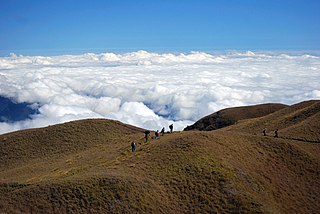
Benguet, officially the Province of Benguet, is a landlocked province of the Philippines located in the southern tip of the Cordillera Administrative Region in the island of Luzon. Its capital is La Trinidad.

La Trinidad, officially the Municipality of La Trinidad, is a 1st class municipality and capital of the province of Benguet, Philippines. According to the 2020 census, it has a population of 137,404 people.

Atok, officially the Municipality of Atok,, is a 4th class municipality in the province of Benguet, Philippines. According to the 2020 census, it has a population of 19,218 people.
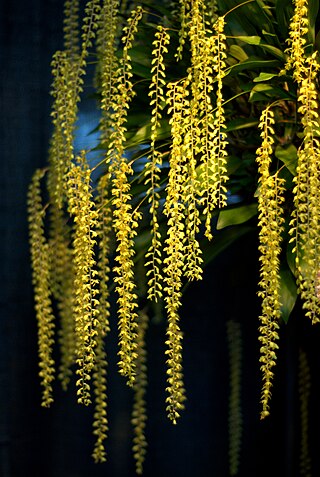
Dendrochilum cobbianum, or Cobb's dendrochilum, described by Heinrich Gustav Reichenbach in 1880, is an epiphytic orchid occurring in the Philippines, growing on moss-covered trees. It can sometimes occur as a lithophyte growing on rocks at altitudes above 1200 m.
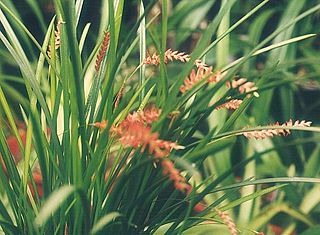
Dendrochilum was a genus of epiphytic, lithophytic and a few terrestrial flowering plants in the orchid family (Orchidaceae). It is now considered to be a synonym of Coelogyne Lindl. The name of this genus was derived from Ancient Greek words dendron ("tree"), and either cheilos ("lip") or chilos, alluding to either the flowers' large lip or to their epiphytic growth. These orchids are popular among fans of non-traditional orchid curiosities.

Dendrochilum glumaceum, the hay-scented orchid or husk-like dendrochilum, was described by John Lindley in 1841. It is an elegant looking epiphytic or lithophytic dendrochilum that occurs in the Philippines and Borneo at altitudes between 700 and 2,300 m.

Begoniaceae is a family of flowering plants with two genera and about 2040 species occurring in the subtropics and tropics of both the New World and Old World. All but one of the species are in the genus Begonia. There have been many recent discoveries of species in the genus Begonia, such as Begonia truncatifolia which is endemic to San Vincente, Palawan. B. truncatifolia is smaller in size than other species of the genus Begonia and this new species is proposed Critically Endangered by standards set by the IUCN. The only other genus in the family, Hillebrandia, is endemic to the Hawaiian Islands and has a single species. Phylogenetic work supports Hillebrandia as the sister taxon to the rest of the family. The genus Symbegonia was reduced to a section of Begonia in 2003, as molecular phylogenies had shown it to be derived from within that genus. Members of the genus Begonia are well-known and popular houseplants.

Mount Hamiguitan is a mountain located in the province of Davao Oriental, Philippines. It has a height of 1,620 metres (5,315 ft). The mountain and its vicinity has one of the most diverse wildlife populations in the country. Among the wildlife found in the area are Philippine eagles and several species of Nepenthes. Some of the latter, such as the Nepenthes peltata and Nepenthes micramphora, are endemic to the area. The mountain has a protected forest area of approximately 2,000 hectares. This woodland is noted for its unique pygmy forest of century-old trees in ultramafic soil, with many endangered, endemic and rare species of flora and fauna.
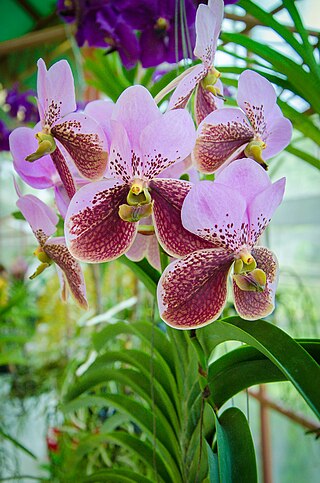
Vanda sanderiana is a species of orchid. It is commonly called Waling-waling in the Philippines and is also called Sander's Vanda, after Henry Frederick Conrad Sander, a noted orchidologist. The orchid is considered to be the "Queen of Philippine flowers" and is worshiped as a diwata by the indigenous Bagobo people.
Begonia balangcodiae is an endemic species of Begonia discovered in Sagubo, Kapangan, Benguet, Philippines. The species was allied to B. esculenta Merr., from which it is distinguished by its cordate leaf base and white tepals, while the latter's leaf base is not cordate and has a vermilion-colored tepals. On the same hand, this species resembles that of B. leucosticta Warburg, differing from the latter on cordate leaf base versus subcordate leaf base, and larger tepals ranging in size from 12 to 18 mm long in pistillate flowers versus the latter's 3–5 mm. Additionally, this species is similar to B. negrosensis Elmer, in that it has lanceolate, glabrous leaf compared to that of latter's obovately oblong and sparsely hairy leaves, and white to greenish tepals, versus that of latter's pinkish tepals.
Begonia beijnenii is a species of flowering plant in the family Begoniaceae, native to the island of Palawan in the Philippines.

The Upper Agno River Basin Resource Reserve is a protected area located on the southeast flank of the Cordillera Central in the Philippine province of Benguet along its border with Ifugao and Nueva Vizcaya. It is a resource reserve located high in the Central and Polis ranges protecting the headwaters of the Agno River. According to section 4 of the National Integrated Protected Areas System Act, a resource reserve is an extensive and relatively isolated area designated as such to preserve the natural resources of the area. The reserve comprises 77,561 hectares of the catchment area that feeds the Ambuklao and Binga dams, two of the country's oldest hydroelectric plants that supply power to the city of Baguio and entire Benguet province. Upper Agno is north of and contiguous with the Lower Agno Watershed Forest Reserve that preserves the immediate downstream of the Binga Dam where the Agno River is impounded by a third dam, the San Roque Dam, the largest in the Philippines and the main source of water, electric energy and irrigation for surrounding regions in Luzon.
Begonia cabanillasii is a species of flowering plant in the family Begoniaceae, native to the island of Palawan in the Philippines.

Begonia caramoanensis is a species of flowering plant in the family Begoniaceae, native to the island of Luzon in the Philippines.
Corybas circinatus is a species of flowering plant from the family Orchidaceae endemic to ultramafic habitats on the island of Palawan, Philippines, The endemic helmet orchid was first photographed at Mount Victoria in June 2007. This species is distinct in bearing a small glandular protuberance at the front of its pedicel, a 4-lobed entire labellum, and a distinctive strongly incurved dorsal sepal. The general colouration of the floral and vegetative parts is also highly characteristic, and the general lowland to mid-montane ecology of the species is unique amongst the known Philippines Corybas. The research was initiated by the Philippine Taxonomic Initiative, Inc.
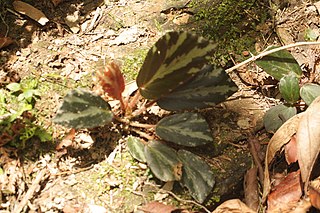
Begonia truncatifolia is a species of flowering plant in the family Begoniaceae, native to the island of Palawan in the Philippines.
Dilochia deleoniae is a species of orchid endemic on Mindanao island in the Philippines. It is the third species of Dilochia known from the Philippines.
The Philippine Taxonomic Initiative (PTI) is a private Philippine research institute and non-profit organization founded in 2018, located in the Philippines.
Amorphophallus minimus is a species of corpse flower found in the Philippines endemic to the Pantabangan-Carranglan Watershed Forest Reserve, Nueva Ecija province. Amorphophallus minimus is 24 cm in height and is the 17th known species in the genus Amorphophallus in the Philippines and is the 198th species of the genus Amorphophallus worldwide. The species has a rust colouration with a lichen like pattern. Amorphophallus minimus grows at an elevation of 950 to 1,400 meters and has a small habitat range.












